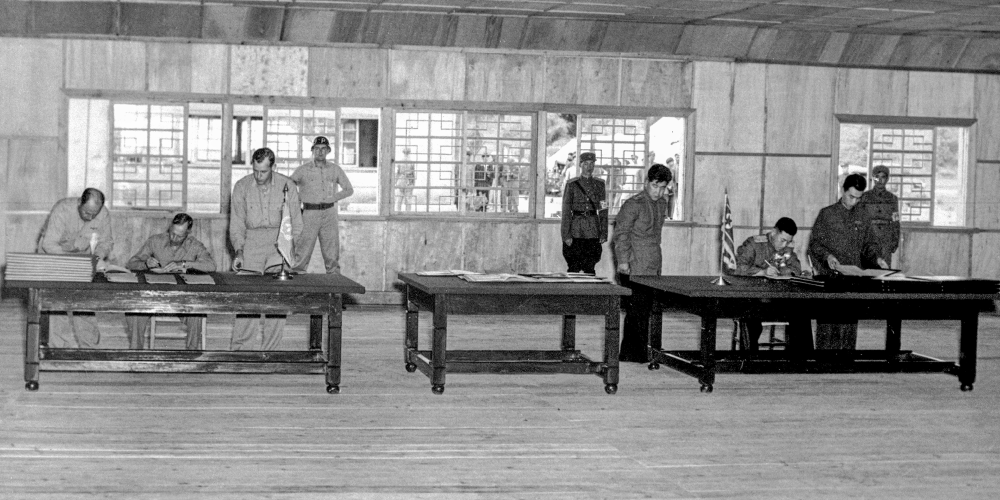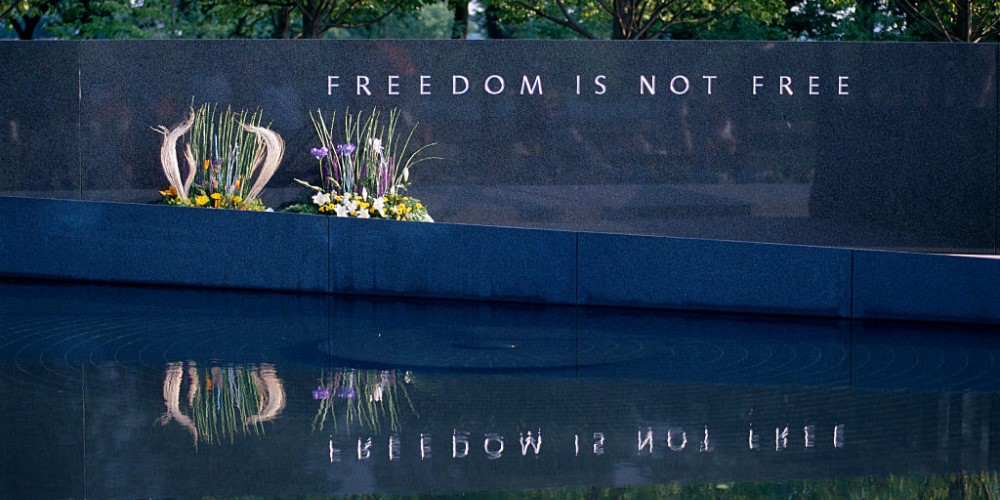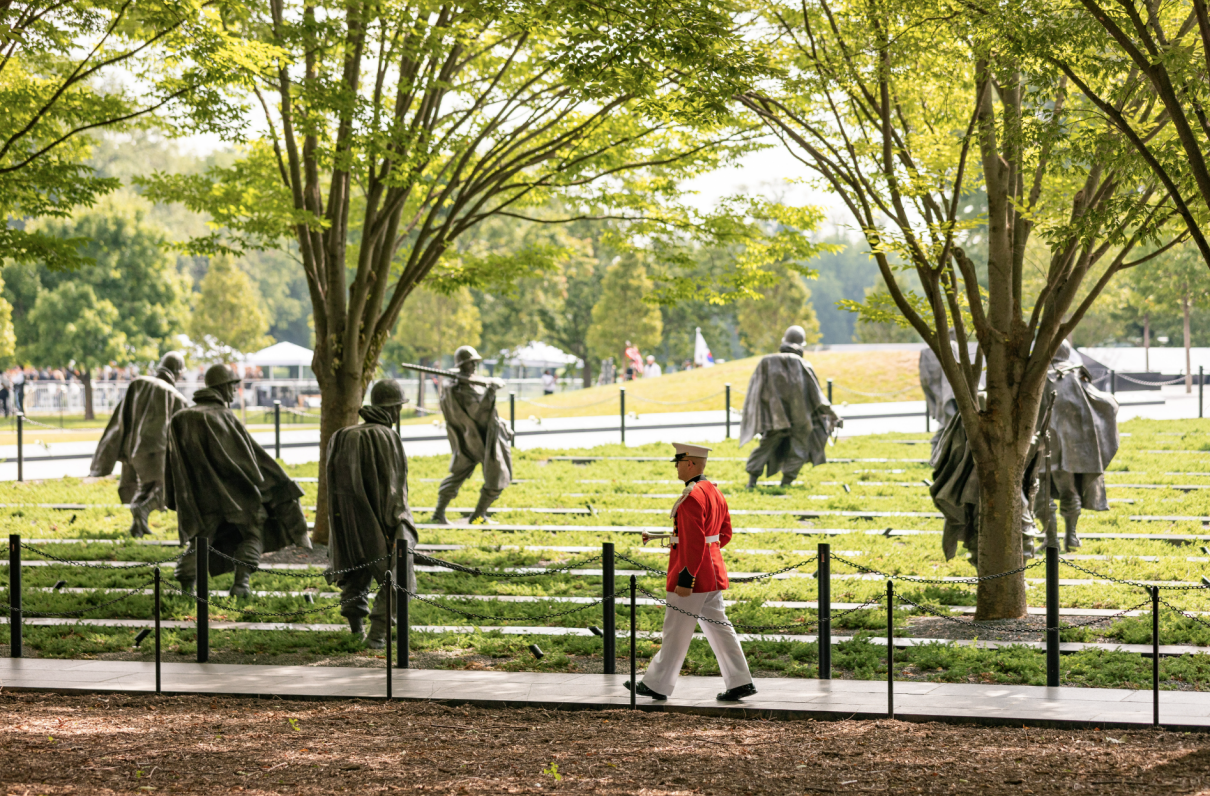This article by Lt. Col. Patrick J. Chaisson, USA (Ret), originally appeared in the July 2023 issue of Military Officer, a magazine available to all MOAA Premium and Life members. Learn more about the magazine here; learn more about joining MOAA here.
Presidential candidate Dwight D. Eisenhower made a pledge Oct. 24, 1952: “I shall go to Korea.”
He told the audience in a speech it was time to conclude the three-year war that pitted a U.S.-led coalition defending South Korean sovereignty against invaders from North Korea and communist China.
Two months later, President-elect Eisenhower made good on his promise to visit the front lines in Korea. What he saw there greatly alarmed the retired Army general.
United Nations troops, fighting alongside their South Korean allies, were seemingly locked into a war of outposts on the heavily fortified border with North Korea. Enemy troops, also dug in deeply, punished the defenders with massive artillery barrages. Neither side could advance, yet every day the casualty lists grew.
While this deadly conflict dragged on, so did a series of negotiations that were held in the tiny Korean village of Panmunjom. Discussions started in July 1951 and continued for another two years. Although the delegates met 185 times during that period, little progress toward peace was made.
[RELATED: Here's How the Senate Wants to Boost Military Recruitment]
The election of Eisenhower, combined with the death of Soviet Premier Joseph Stalin, convinced communist rulers that reopening truce talks in Korea might help ease Cold War tensions. The war officially ended July 27, 1953, when military officers from the United Nations, the North Korean People’s Army, and the Chinese People’s Volunteer Army signed a ceasefire agreement known as the Korean Armistice.
This month marks the 70th anniversary of that armistice. It accomplished many critical tasks, such as an immediate suspension of hostilities and establishment of the Demilitarized Zone that separated the combatants. Arrangements were also made to repatriate those persons held as prisoners of war.

General W.K. Harrison Jr., USA, left, and North Korean General Nam Il, right, sign the armistice ending the three-year Korean War in July 1953 in Panmunjom, Korea. (Photo by Interim Archives/Getty Images)
The armistice was a military truce; no formal peace treaty has ever been negotiated. Technically, the Korean peninsula remains in a state of war today.
Many of the 1.8 million Americans who served in Korea from 1950-53 struggled to accept this idea of a ceasefire without victory.
Col. Warren H. Wiedhahn, USMC (Ret), a MOAA member and Korean War veteran, said he felt the armistice was “anticlimactic” — nothing much changed except the shooting had stopped.
Some Americans preferred to put the conflict behind them. Korea became known as “The Forgotten War,” as it was largely overshadowed in public memory by the catastrophic events of World War II and Vietnam.
In time, however, the U.S. began to acknowledge the sacrifices of those who served the cause of freedom during this three-year conflict.
[MOAA PRESENTS: Vietnam Unchronicled]
The Korean War Veterans Memorial, located on the National Mall in Washington, D.C., has served as a place of remembrance for veterans, families, and the public since its dedication in 1995.
One striking feature of the memorial is a field containing 19 statues — each about 8 feet tall — that depict U.S. servicemembers on patrol. Other sections include a mural wall, a reflecting pool, and a granite curb recognizing the 22 nations that contributed troops to the United Nations effort in Korea.
The newly installed Wall of Remembrance, dedicated July 27, 2022, lists the names of 36,634 Americans and 7,174 Korean Augmentation to the United States Army soldiers who gave their lives during the Korean War.
Nearby, an inscription reading “Freedom Is Not Free” also reminds visitors of the conflict’s human toll.

Photo by Wally McNamee/CORBIS/Corbis via Getty Images
The Korean War Veterans Memorial Foundation works to help preserve this unique outdoor space.
Serving as foundation chairman is Gen. John H. Tilelli Jr., USA (Ret), a former chairman of MOAA’s board of directors. Tilelli’s last military assignment was as commander in chief of the United Nations Command, Republic of Korea/United States Combined Forces Command/United States Forces Korea.
Tilelli recently told Military Officer about the significance of the Korean Armistice in today’s world.
“There are several things to remember on this 70th anniversary of the armistice,” he said. Of primary importance are “the soldiers, Marines, sailors, and airmen who fought and those who died for freedom in the Republic of Korea.”
Tilelli said the Korean Armistice, taken together with the subsequent Mutual Defense Treaty between the Republic of Korea and the U.S., has “provided deterrence and peace and security on the peninsula and generally in the region. It has also created a model alliance between the U.S. and the Republic of Korea that works hand in hand solving many security issues.”
Lt. Col. Patrick J. Chaisson, USA (Ret), is a writer, historian, and MOAA member in Scotia, N.Y.
Military Officer Magazine
Discover more interesting stories in MOAA's award-winning magazine.
